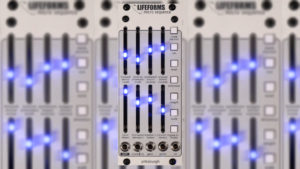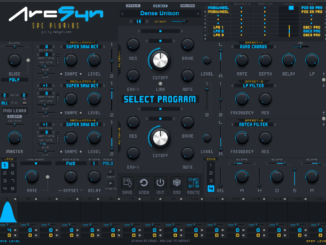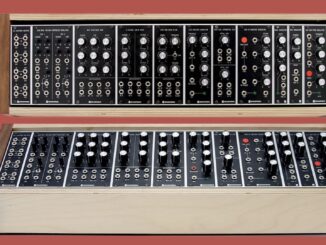Sequencers for the Eurorack format are very exciting modules. Often, however, they are very large and rather impractical for compact mobile setups. So for this reason, musicians often decide to use again the computer to send out MIDI sequences from Ableton Live, Native Instruments Reaktor 6… to a Eurorack MIDI interfaces.
For some time, Eurorack developers have been responding to this space problem with new compact, interesting sequencer modules like the XAOC Devices Tirana 2 sequencer. The US based company Pittsburgh Modular just introduced the new Lifeforms Micro Sequence, a new powerful and versatile 8 step sequencer in the 10hp size for the Eurorack format.
With a simple, performance focused interface, the feature set of the Lifeforms Micro Sequence module speaks for itself. Eight sliders with integrated channel mute. Eight quantized scales. Eight sequencer direction modes. Sequences up to 8 steps. Four external modulation functions. Integrated tap tempo clock. Eight step external clock divider. Run/Stop transport button. Sequence reset button. Dedicated analog CV output. And more….
Compact Eurorack Sequencer With The Most Important Inputs and Outputs
The new Lifeforms Micro Sequence is a powerful 8 step sequencer with a lot of useful features. It comes with independent quantized pitch and analog CV outputs, 8 dedicated channel sliders with a integrated mute function as well as a modulation gate input (assignable to one of four functions (reset, hold, reverse, ratchet) and four outputs (quantized pitch, 0 to 5 volt analog CV output, 5 volt gate output, 5 volt Tap Tempo Clock Output). On the faceplate, you have also a dedicated run and reset button.
Different Scales, Gate Functions As Well As Direction Modes Allow Complex Sequences
Pittsburgh Modular have developed here not only a compact but also a very musical sequencer. First, it features 8 different sequencer direction modes that range from more standard to very complex onces (Forward, Reverse, Pendulum, Stagger, Skip, Transpose, Random, Random With Rest).
- Forward – The sequence steps between channels 1 to 8 in order. Channel 1 represents step 1.
- Reverse – The sequence steps between channels 8 to 1 in reverse order. Channel 8 represents step 1.
- Pendulum – The sequence steps between channels 1 to 8 then reverses direction. Channels 1 and 8 are triggered twice to create a 16 step sequence length. Channel 1 represents step 1.
- Stagger – The sequence steps between channels 1 to 8 in order with a 25% chance that the sequence will stagger back 1 step or ahead 2 steps. This creates a sequence that staggers back and forth as it steps between channels. Channel 1 represents step 1. Step 1 may be staggered past on any given cycle.
- Skip – The sequence steps between channels 1 to 8 in order, skipping a subsequent channel each cycle. This creates a complex sequence of 56 steps. The first time through channel 1 is skipped, the second time through channel 2 is skipped, and so on. Channel 2 represents step 1 because Channel 1 is skipped on the first sequence cycle.
- Transpose – Transpose splits the sequencer into two sets (channels 1-4 and channels 5-8). The top sequence (channels 1-4) is transposed by the bottom sequence (channels 5-8) running at 1/4 the rate as the top sequence. Channel 1 and channel 5 active represents step 1.
- Random 1 – The active channel is selected randomly. There is no step 1 tied to random. Program changes happen immediately.
- Random 2 – The active channel is selected randomly with the chance of a rest. There is no step 1 tied to random. Program changes happen immediately.
Additional, users can work with the Lifeforms Micro sequencer with a more music theory in the mind and have 8 quantized scales to choose from (Micro Tuning, Chromatic, Major, Minor, Blues, Phrygian, Lydian, Dorian Scales) that you can access directly on the module.That’s not all! The Lifeforms Micro sequences comes also with several gate in modes (reset, hold, reverse, ratched). The gate in mode button assigns the external gate input jack to one of four modulation destinations.
- Reset – The sequence resets to step 1 when the incoming gate signal goes high.
- Hold – The sequence pauses on the active step while the incoming gate signal is high.
- Reverse – The sequence direction reverses when the incoming gate signal goes high. The sequence returns to normal when the gate goes high a second time. If the direction mode is set to random 1 or random 2, reverse mode enables the sequence to play forward.
- Ratchet – The sequence gate output triggers 4 times per clock cycle while the incoming gate signal is high.
Full List of Features
- 8 Step Sequencer
- 8 30mm Dedicated Channel Sliders with Integrated Mute
- Independent Quantized Pitch and Analog CV Outputs
- 8 Quantized Scale Options (Micro Tuning, Chromatic, Major, Minor, Blues, Phrygian, Lydian, Dorian Scales)
- 8 Sequencer Direction Modes (Forward, Reverse, Pendulum, Stagger, Skip, Transpose, Random, Random With Rest)
- Assignable Pattern Length From 1 to 8 Steps
- Modulation Gate Input Assignable to One of Four Functions (Reset, Hold, Reverse, Ratchet)
- Internal Tap Tempo Clock
- 8 External Gate or Trigger Clock Divider Options (÷1, ÷2, ÷3, ÷4, ÷5, ÷6, ÷7, ÷8)
- 4 Octave Quantized Pitch Output Range
- 0 to 5 volt Analog CV Output
- 5 volt Gate Output
- 5 volt Tap Tempo Clock Output
- Run / Stop Transport Button
- Pattern Reset Button
An exciting new compact and affordable sequencer from Pittsburgh Modular that fits perfectly in many mobile setups in my opinion. Looking forward to get my hands on it.
The Pittsburgh Modular Lifeforms Micro Sequence will be available soon for a price of $199 USD from any retailer.





Be the first to comment